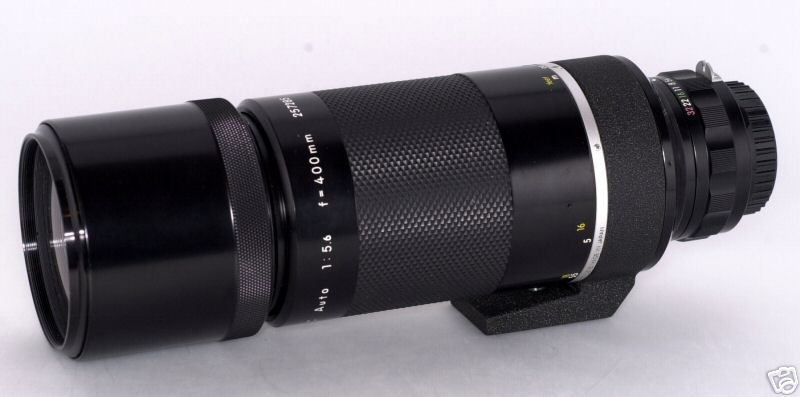
THX 2 photosynthesis.co.nz!
Auszug aus der Bedienungsanleitung:
The Nikkor Auto 400mm f/5.6 is a compact, lightweight long-focus lens of telephoto design with a 1:0,74 ratio. Its use of fluorite crystal and special rare earth glass helps correct aberrations especially chromatic ones. The multi-layer coating on glass surfaces provides significant gain in image contrast, minimum flare at wide apertures, absence of ghost and assures natural color transmission. Automatic diaphragm control guarantees the brightest possible image in the focusing screen for easy focusing. And the lens coupling prong connects the lens with the Photomic and Nikkormat TTL Meters for full-aperture reading. Shifts in focus caused by thermal expansion are compensated for by the focusing ring which moves past the infinity mark.
The lens has a built-in collapsible hood and a tripod socket which rotates a full 360° - at click-stopped incresements of 90° - to permit shooting on a tripod in either horizontal or vertical formats. To rotate the lens loosen the locking screw and turn the lens until it clicks into place.
Ideal for sports events, nature study and wildlife photography where high performance and compact size are required.
Technische Daten:
Focal length/aperture: 400mm f/5.6
Picture angle: 6°10'
Lens construction: 5 elements in 3 groups
Diaphragm: Automatic, stops down to 32
Meter coupling prong: Provided
Focusing range: Infinity to 16ft (5m)
Filter size: 72mm screw-in
Dimensions: 84,5mm diameter, 263mm length
Weight: 1,4kg
Weiterführende Links:
Bewertungen:
Archiphoto schreibt: 400/5.6 - This is the old PC lens from about 1970; it was the first 'ED' Nikkor, although it is not designated as such. The sharpest, highest contrast telephoto I know of. Better than Nikon's 400/5.6 IF, or even the 400/3.5 IF. On the downside, the handling is poor as it is not IF.
Rorslett gibt dem Objektiv eine 4,5 von 5!
"Introduced in 1973, this lens remained in production only a few years until replaced by a similarly sized lens with a gold band indicating that the front element contained ED glass. However, the lens above, according to the papers, actually contains fluorite crystal and special rare earth glass which has been multi coated. Take that! No wonder its production run was so short. The lens contains 5 elements in three groups. (1,412 total units produced.)
Mechanically, the lens has a focus throw that is really long that makes it difficult to rapidly focus from close up to infinity. The built in lens hood and 360 degree rotating tripod collar were ahead of their time.
Optically, the lens is corrected for all three primary colors which makes it critically sharp for stationary subjects."
Peter Braczko hat geschrieben: Ein sehr schönes, langbrennweitiges Tele-Nikkor mit großzügig dimensionierter Einstellfläche und griffigem Blendenring. Mit der Motorkamera sind noch gut Schnappschüsse aus der freien Hand möglich. Fest angebaute Stativhalterung, großzügig gestalteter Berg und Tal Ring für die Blendeneinstellung, ausziehbare Sonnenblende. Zum Zeitpunkt der Vorstellung das längste Teleobjektiv mit Blendenmitnehmer. In den 70er Jahren der Geheimtip bei den Modefotografen, heute sehr gesucht unter den Nikon-Fans. Serienproduktion ab Nummer 256011 oder 256022. Gebaut bis September 1975, Endnummer 257440.



